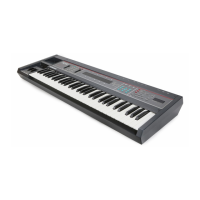SO-80 — Musician's Manual
Another useful shape is a simple pitch Envelope. You can, for example, imitate the way Horns often
"slide" into a note, rather than begin-
ning right on pitch. By setting TIME 1
to Zero, LEVEL 1 to some negative
value, and LEVEL 2 and LEVEL 3 to
Zero, you now have an Envelope
which, when used to modulate Oscilla-
tor Pitch, will cause the pitch to "slide"
up to the proper note in the amount of
time defined by TIME 2.
This could be a rather long, dramatic "slide", or an almost imperceptibly short one, depending on the
value you assign to TIME 2. How much the Pitch is altered will depend on the value of LEVEL
1 and
the Modulation depth.
Velocity Control Of Envelopes
There are two parameters on the Envelope Page which allow you to alter an Envelope depending on
ke
y
board velocity, or how hard you strike a key.
[LV] Velocity Level control
The first of these, LV or Velocity Level Control, will lower all three levels (L1, L2 and L3) with a softe
keystrike. This means that the settings you assign to LEVEL 1, LEVEL 1 and LEVEL 3 are maximum
Levels, the Levels that will be reached with the hardest keystrike. The amount of LV determines how
much those Levels will be reduced as you play softer. Two different velocity curves are available.
With this parameter you can have con-
tinuous dynamic control over the three
levels by varying how hard you play.
The most common uses of the
elocit
Level Control have to do with varying,
the volume and brightness of a Pro-
gram, though in the previous example,
(LV] could be used to alter the depth o
the Pitch Envelope with velocity.
Linear or Exponential Velocity Response
As with TIME 4, The range of the parameter LV actually goes from 0 to 63 twice:
• Values from 00
L to 63L will cause velocity to affect the level in a linear fashion — level increases
proportionally with velocity.
• Values from 00X to 63X will cause the Envelope's level to increase exponentially with velocity.
That is, the Envelope will not increase to maximum level except at the very top of the velocity
range. By assigning these exponential values to
LV, you can create dramatic changes in pitch, timbre
and Oscillator volume which occur only when you play a note really hard. The illustration on the
next page shows the difference between the behavior of linear and exponential values of
LV (the
illustration assumes values of
63L and 63X respectively),
62 Section 3 — Voice Programming

